Pictures From a Panama Canal Transit on Celebrity Infinity

On This Page
- Panama City Sailaway
- The Bridge of the Americas
- The Miraflores Locks
- The Celebrity Infinity Bridge
- Uncle Marty's Canal Commentary
- The Panama Canal Locks
- "Kissing" the Locks' Walls
- The Miraflores Locks Gates
- The Panama Canal Expansion
- Panama Canal-Watching
- The Culebra Cut
- Canal Cruise Neighbors
- Gatun Lake
- The Gatun Locks
- Colon, Panama
- Casco Viejo (Panama City)
- Canal Wildlife
- The Panama Railroad
- From Panama to Colombia
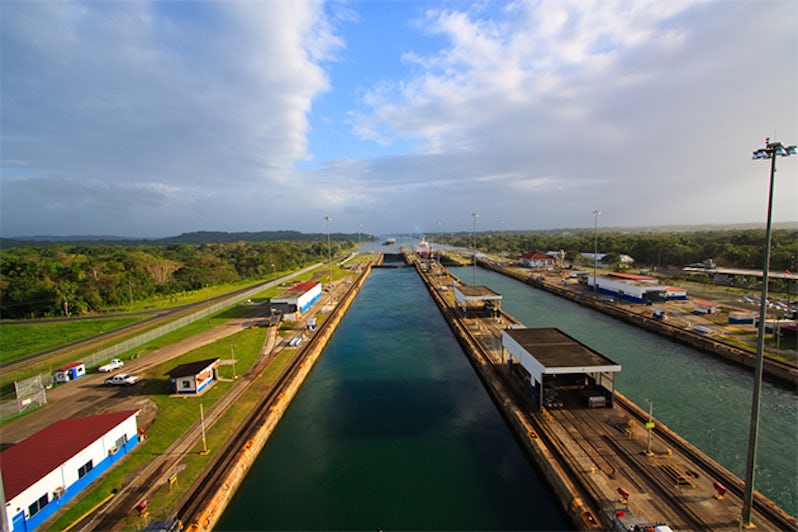
A Panama Canal cruise seems to be on many cruisers' bucket lists -- and for good reason. Transiting the canal on a cruise ship is an up-close and comfortable way to experience this engineering marvel, often called "the eighth wonder of the world."
The canal is only one facet of this memorable journey. Shore excursions from the port of Colon allow cruisers with military ties to the Canal Zone to explore former bases and once sleepy Panama City, now a thriving metropolis. For the eco-minded, day trips visit Panama's jungles, rivers and lakes, home to exotic plants and animals, including very large and always-hungry crocodiles.
We discovered these wonders for ourselves during a late-April cruise on Celebrity Infinity from San Diego to Fort Lauderdale. During our voyage, we visited other colorful Latin American ports of call, but none equaled the excitement that rouses passengers at dawn to witness the daylong canal transit from the Pacific Ocean to the Atlantic.
Unless you're a hydraulic engineer, the 48-mile transit isn't postcard pretty, except perhaps for "island"-dotted Gatun Lake. But it is thrilling, especially given the enormous engineering, political and health challenges that were overcome to carve this waterway through impenetrable jungle in the early 20th century.
During the centennial celebrations in 2014 and the completion of the canal expansion a few years after, more cruisers have been inspired to personally experience this triumph of human ingenuity from a balcony or air-conditioned deck. For those adventurers, the following slideshow highlights the canal's complex operations and captures the passage from a cruiser's point of view.
--By Ron and Mary James, Cruise Critic contributors
Panama City Sailaway
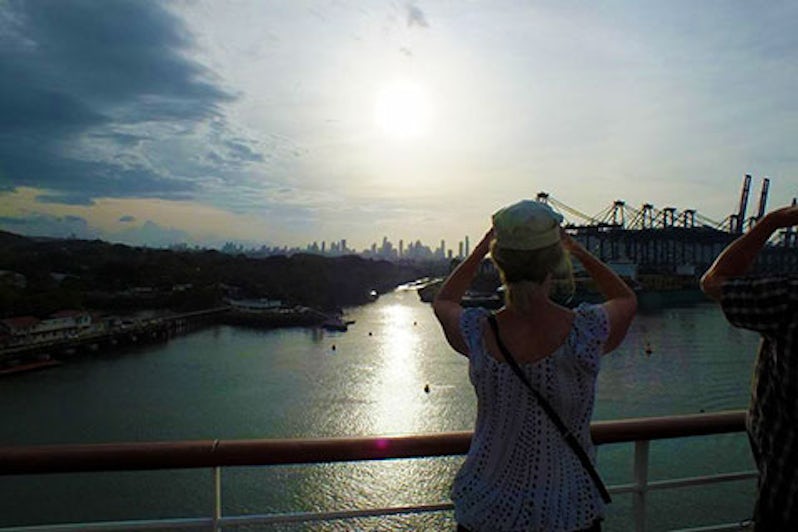
Early risers say farewell to the Pacific Ocean to get a great view of the impressive Panama City skyline and cargo cranes that line the docks at the Port of Balboa. Celebrity Infinity and most other cruise ships don't dock on the Pacific side of the canal -- although a handful of cruise ships drop anchor and tender to the island of Fuerte Amador, which is connected to Panama City by a mile-long causeway. We eventually docked in Panama at a large cruise facility in Colon on the Atlantic side. Cruise passengers who wanted to visit Panama City had to travel back across the isthmus by taxi, bus or train from Colon. Traffic on the road can be problematic, so the ship's shore excursions are the best and safest way to explore Panama City.
The Bridge of the Americas
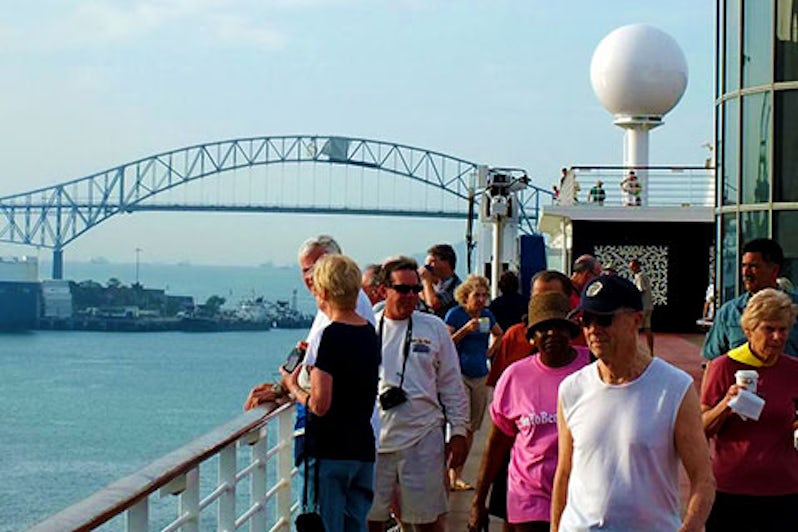
About 6 a.m., the ship glided toward the landmark Bridge of the Americas and canal entrance, where cruise ships are given priority transit because of their fixed sailing schedules. Thus begins the transit, which -- depending on congestion and the weather -- lasts an average of eight to 10 hours. At the Miraflores Locks, ships are raised 54 feet. After passing through Miraflores Lake, the Pedro Miguel Lock lifts them another 31 feet to the ultimate canal elevation of 85 feet above sea level. The narrow 7.8-mile Culebra Cut or channel at the Continental Divide then empties ships into Gatun Lake. They continue on a 15-mile journey to the final set of locks and, ultimately, the Atlantic Ocean.
The Miraflores Locks
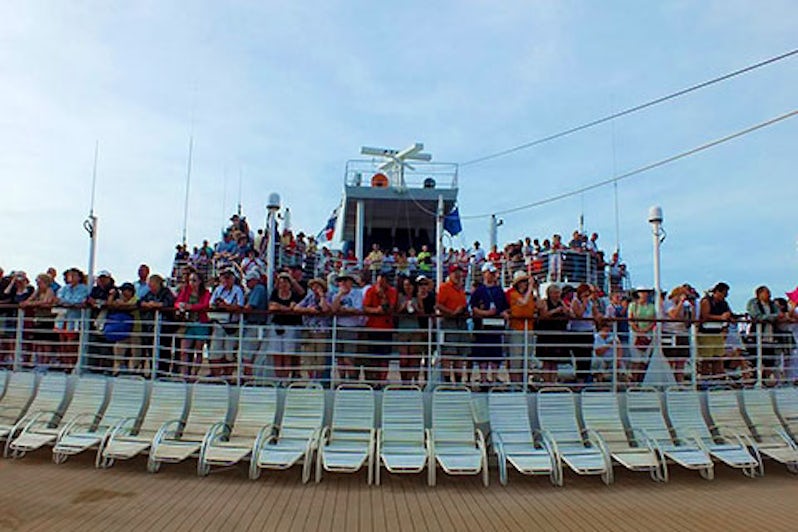
Around 8 a.m., the ship neared the Miraflores Locks, and eager passengers jammed the forward decks for prime viewing as the ship entered the locks. A few testy words punctuated the constant jostling for unobstructed views, but most passengers kept their cool and savored the moment. Sunscreen, hats and plenty of water were essential, as temperatures climbed into the 90's and the humidity skyrocketed.
To guarantee a prime viewing spot at the bow, get into position early. The ship's transit time is announced the previous day so passengers can plan accordingly. Try to view the canal's workings from many locations around the ship to find varied perspectives and dodge the crowds. After the first set of locks, crowds on the top forward decks diminish significantly, as many trade their sun-baked posts for shaded balconies or air-conditioned lounges.
The Celebrity Infinity Bridge
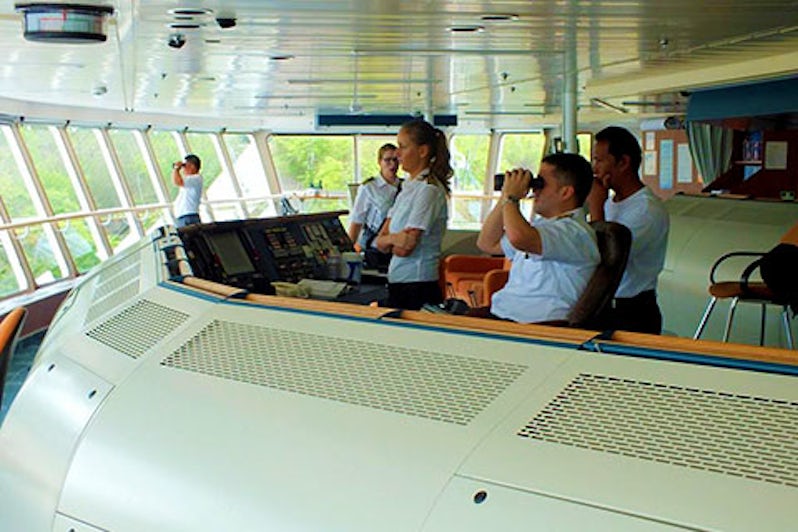
On the bridge, the officers' cool, quiet professionalism was in vivid contrast to the passengers' excitement. The mandated Panamanian pilot and Infinity's popular Staff Captain Thomas Hinderhofer (both holding binoculars) monitored traffic, ranging from small catamarans and yachts to giant cargo vessels stacked high with colorful containers. Two Panamanian pilots onboard worked in shifts. Each pilot had a cabin reserved for him to rest between stints on the bridge. Aiding the pilots were about two dozen Panamanian crew who work the lines to the eight "mules," or locomotives, that help guide the ship in and out of the snug locks.
Uncle Marty's Canal Commentary
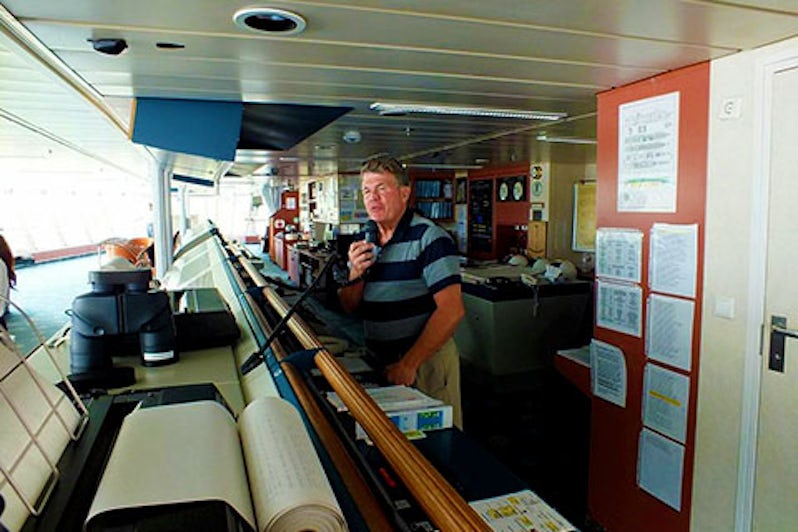
Martin Harrington, a Panamanian affectionately known to crew and passengers as Uncle Marty, was the informed voice of Infinity's transit. For nearly eight hours, he delivered lock-by-lock commentary over the ship's PA system from a microphone on the bridge. Uncle Marty is known to all aboard from his standing-room-only talks on Panama and the canal during the preceding days of the cruise. His five lectures are archived on the ship's dedicated Panama TV Channel, along with a couple of canal documentaries, for viewing any time during the cruise. Uncle Marty's quirky soft monotone and folksy style was enjoyed by most cruisers, but for a handful of others, it was a bit too much.
The Panama Canal Locks

One container ship (right) is being raised to the first stage of the lock, and another in the distance has been lifted 54 feet into Miraflores Lake. Staff Captain Thomas Hinderhofer explained the complex engineering of the canal locks by describing it simply as "a water elevator." Visually, though, the first set of locks, Miraflores, seems to resemble a truncated, two-staired water escalator, lifting ships up and lowering them down -- in this photo, both "escalators" are going up. The Pedro Miguel locks have only one stage or step, and Gatun has three.
"Kissing" the Locks' Walls
")
Celebrity Infinity is 106 feet wide, and the locks are 110 feet wide. That leaves two feet of space on each side -- not much room for error. No wonder ships sometimes "kiss" a lock's concrete wall in passing. When our transit was complete, we learned Infinity got a kiss, but it was just a peck, and no damage was done.
Though officially warned not to touch the lock's walls, passengers find it hard to resist as the ship sways ever so close to the off-limits trophy. We were sorely tempted, but we couldn't find the right deck access to do the deed. (Obviously lower decks are best.) The outlaws shown here were definitely more tenacious and clever than we were.
The Miraflores Locks Gates
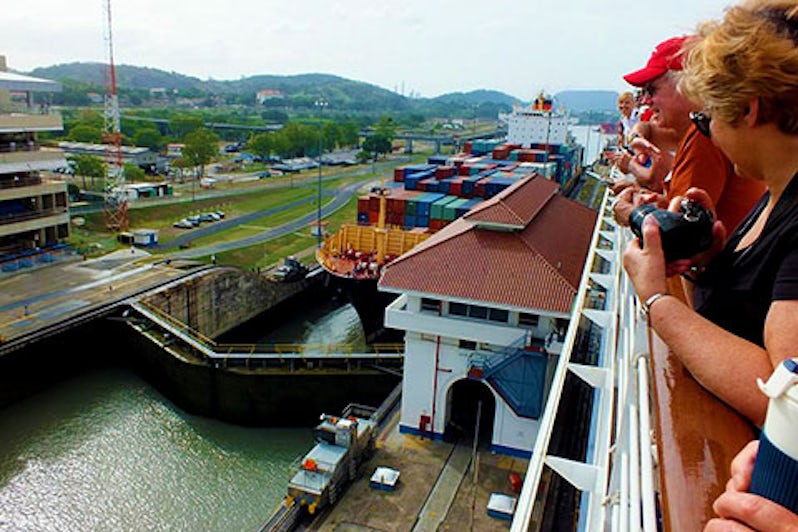
Each massive steel gate at the Miraflores Locks measures 7 feet thick, 65 feet wide and 82 feet high and weighs more than 660 tons. When a pair closes, they form a "V" shape, which uses the upstream water pressure to prevent leaks and hold the gates together. Amazingly, the huge doors are so well balanced that they're powered by a 40-horsepower electric motor. A silver locomotive, or "mule," standing by below was one of dozens along the canal that steady and guide transiting ships. Infinity requires four mules on each side of the ship, two in front and two in the rear.
The Panama Canal Expansion
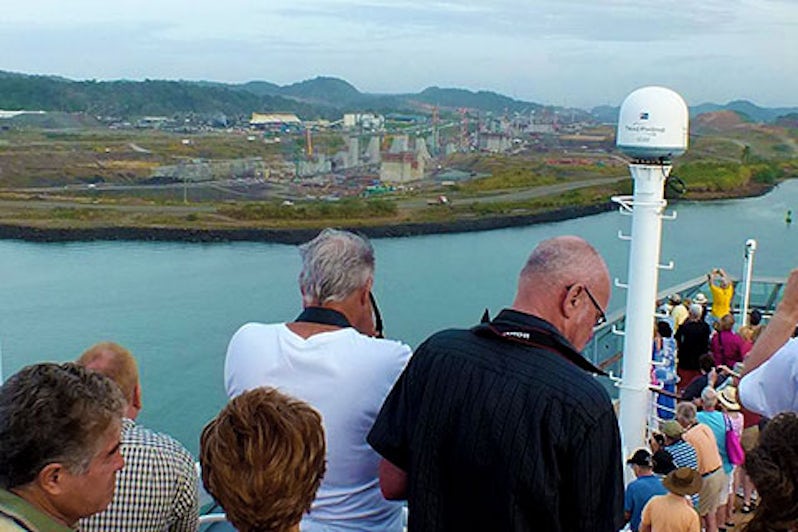
At the Miraflores Locks' exit, the massive construction site of the new third set of locks comes into view. Originally set for completion in 2014, the canal's centenary, the expansion is likely to take another two to four years to finish. The new locks will be substantially larger than the current ones at 180 feet wide, 1,400 feet long and 60 feet deep and will accommodate bigger ships. It's not clear yet if cruise ships will be among them; if so, ships much larger than Infinity could transit in the future.
Panama Canal-Watching
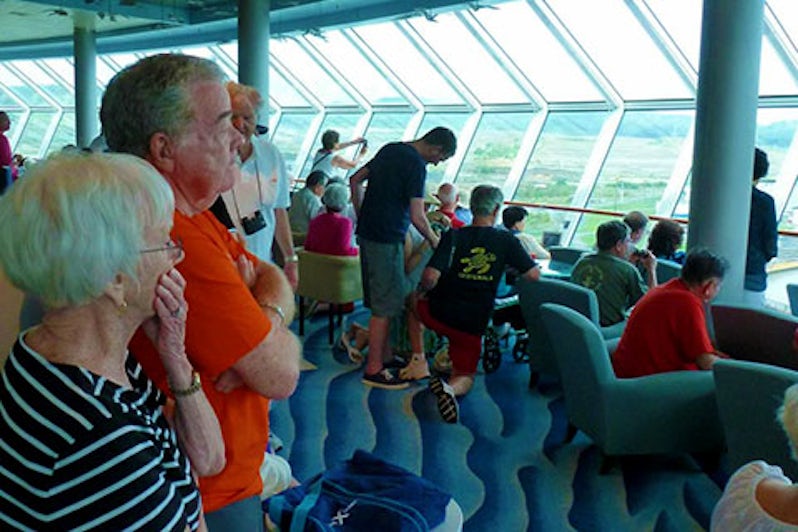
There was an ebb and flow of canal-watching throughout the day, depending on what was happening outside. Navigating through the locks has the most crowd appeal, drawing passengers out of the air-conditioned spaces into the heat and humidity of the outside decks. The lunchtime passage through Gatun Lake found many watching the scenery from the Oceanview Cafe or specialty restaurant Qsine. Others headed to the Constellation Lounge on Deck 11 to enjoy its panoramic views, while a few sipped specialty coffees and gazed out a window. Some returned to their cabins to read, rest or nap. There are no major shipboard activities scheduled during the transit, Bingo included. "When you go up against the canal," says cruise director Patti Honacki, "the canal always wins."
The Culebra Cut
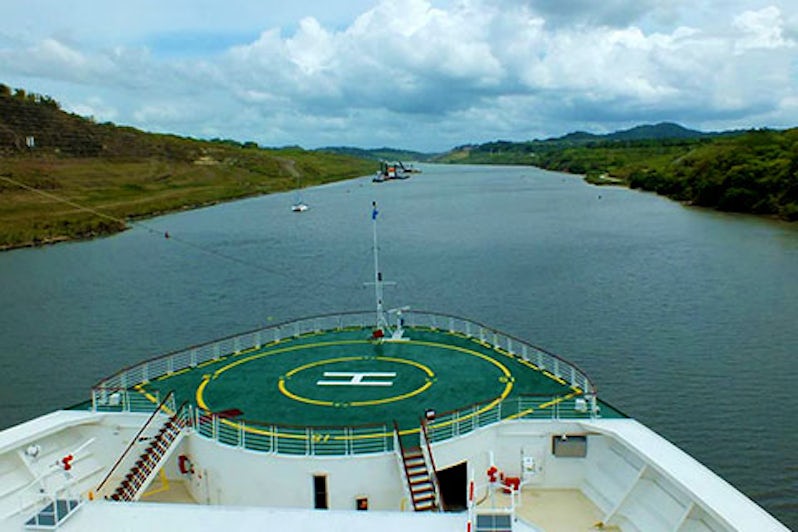
The nearly eight-mile-long Culebra Cut, while not as tight as the locks, is the narrowest part of the canal. This link from the first locks to Gatun Lake is a navigational challenge, as this pilot's eye view shows. Here, and throughout the journey, the Panamanian pilot is in constant contact with the canal's Operations Center, which monitors traffic and potential hazards. The channel was also dotted with dredging barges, which tightened the passage, especially when two large ships approached each other. The dredging is designed to deepen the channel for larger ships that will navigate these waters when the new locks are operational.
Canal Cruise Neighbors
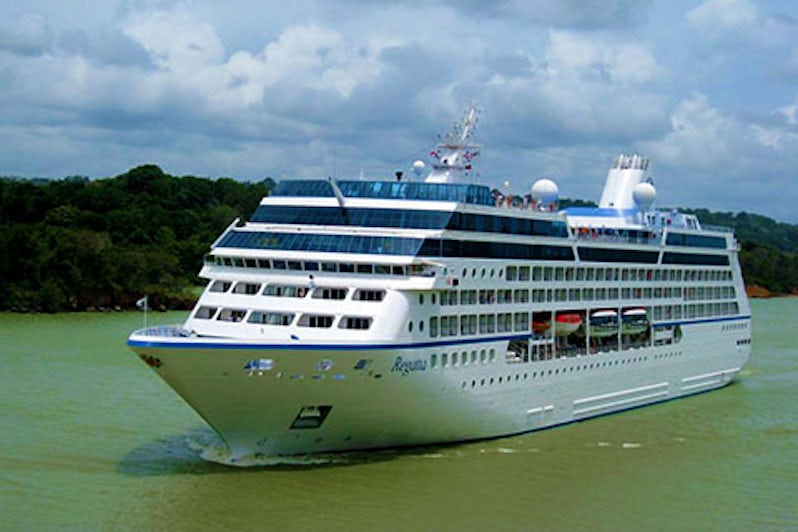
On Gatun Lake, Infinity passed two other cruise ships, including Oceania's Regatta, headed in the opposite direction. Cruise ships pay from $320,000 to more than $400,000 per canal transit, based on size and number of passengers and crew. Cargo ship fees are comparable, while a sailboat only pays a few hundred dollars. All ships and boats must wire payment into the Panama Canal Administration's bank account at least two days before their transits. No credit cards, checks or IOU's are accepted.
Gatun Lake
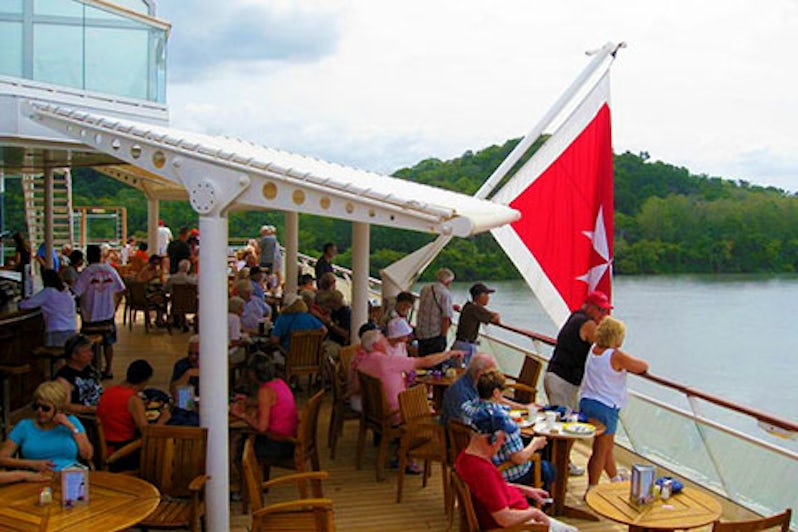
The deck outside the Oceanview Cafe at the stern of the ship afforded passengers broad views of Gatun Lake, the largest manmade lake in the world prior to Lake Mead. What look like islands dotting the lake are really the tops of jungle-covered mountains almost completely submerged when the Chagres River was dammed almost a century ago. The ship does not dock or tender at Gatun Lake. Passengers will have to wait until the morning, when the ship docks at Colon, to take a bus back for Gatun Lake shore excursions.
The Gatun Locks
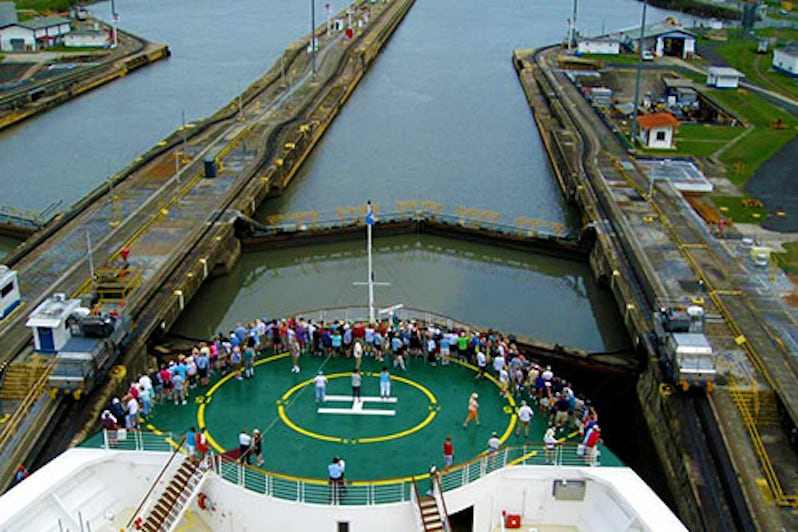
When the ship began its three-stage descent from Gatun Lake to the Caribbean Sea through the Gatun Locks, our transit was nearing its end. There was a surge of renewed interest, and passengers lined the helicopter pad for a last glimpse of the canal's engineering marvels and entry into the Atlantic Ocean. It was a great experience, but eight hours of locks, heat and Uncle Marty were just about right for any cruise.
Colon, Panama
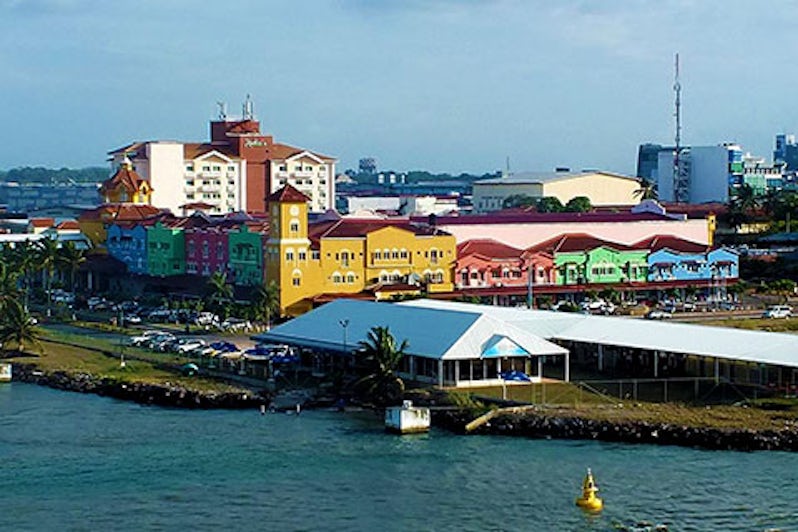
Early the next morning, we docked at the Colon 2000 Cruise Terminal complex. It's a colorful Potemkin village-like shopping center, reflecting neither the architecture nor state of disrepair of buildings in the surrounding city of Colon. Its restaurants, bars and many tourist-oriented souvenir and gift shops lure passengers throughout the day, offering a safe haven from the mean streets of Colon. There are no walking tours of the neighborhoods of Colon, although shore excursions buses and vans must pass through the decaying, crime-ridden city to get to other destinations. The overwhelming poverty and dilapidated buildings in Colon were a stark contrast to modern downtown Panama City, less than an hour away.
Casco Viejo (Panama City)
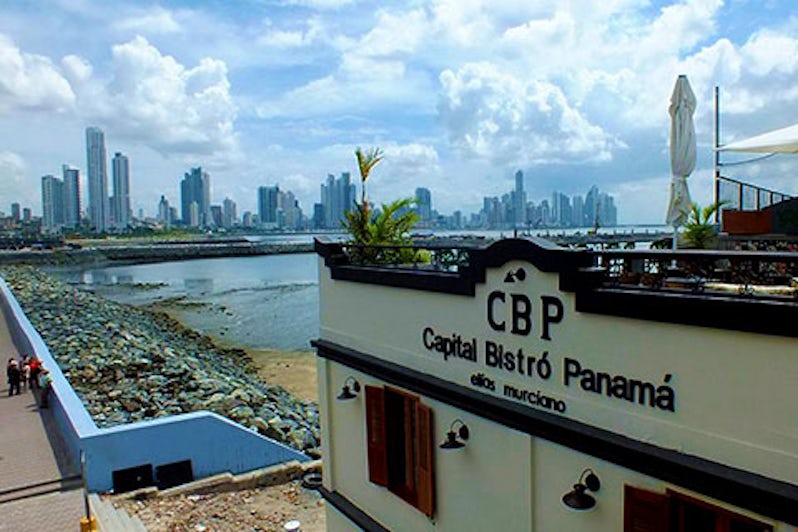
The impressive skyline of ultra-modern Panama City could easily be confused with Miami or other modern cities around the world. Infinity's shore excursions didn't explore downtown, but, instead, focused on the historic Old Panama sections of the city. The highlight was Casco Viejo, a historic district -- settled in 1673 and now a UNESCO World Heritage Site -- with a mix of nearly 800 Spanish and French Colonial churches, museums, shops and apartment buildings in varying states of preservation and decay. Street vendors sell "Panama" hats, a popular souvenir. Made in Ecuador, these hats were made famous when President Teddy Roosevelt wore one on a canal visit. Our tour continued with drives through former U.S. military bases and a stop at the Miraflores Locks Visitor's Center with observation decks overlooking the locks. With fresh memories of the transit, the observation center was anti-climatic.
Canal Wildlife
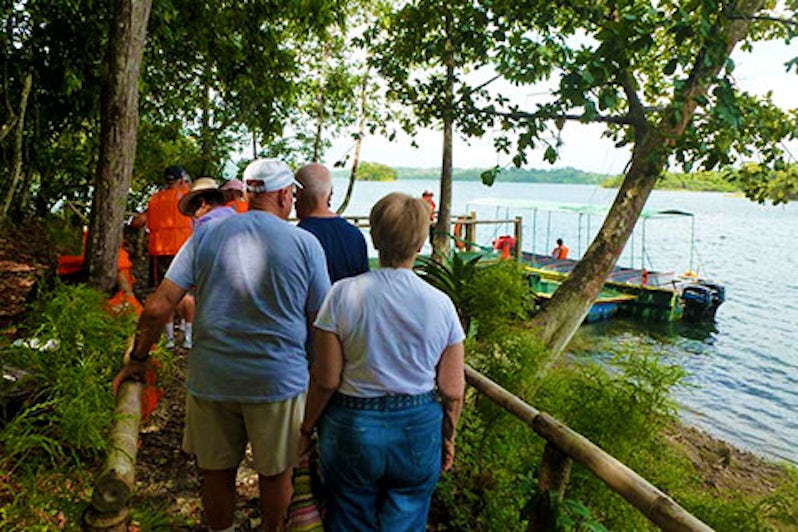
While one member of our party explored Old Panama, another opted for one of several eco-oriented tours that ventured into Panama's wild side. During a Gatun Lake boat tour, the eagle-eyed skipper/naturalist pointed out shy sloths, monkeys and birds in the dense jungle, also home to mango trees weighed down with fruit. Sightings were few but fun (binoculars are essential), and lake breezes banished the heat for the two-hour ride on calm water, well away from transit traffic. Before returning to the ship, the tour also stopped at Gatun Locks. Other eco-tour options included catch-and-release bass fishing on Gatun Lake, kayaking and visiting a village of the indigenous Embera Indians.
The Panama Railroad
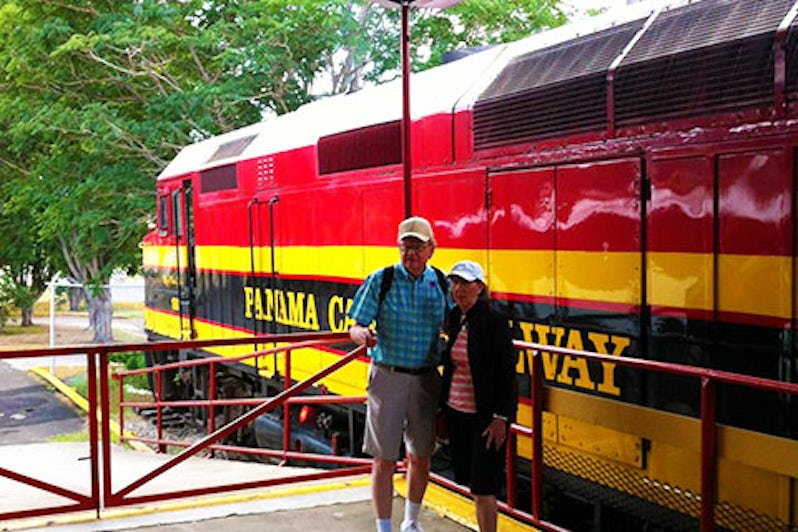
Train enthusiasts, like our journalist shipmate Carl Larsen, won't want to miss the excursion on the American-owned Panama Railroad, the world's first transcontinental railway. In addition to passengers, it hauls giant containers across the Isthmus from ships too large for the canal transit. Carl reports, "If you know a bit of history, the ride becomes more fascinating. The railway preceded the canal as a link between the two oceans and cost hundreds of lives to build in what today seems to be a tame environment. There's little evidence of the once-frequent washouts that plagued the line and bridges along the way." To experience the train, you have to sign up for an excursion, often combined with sightseeing in Old Panama, as regular passenger service is limited.
From Panama to Colombia
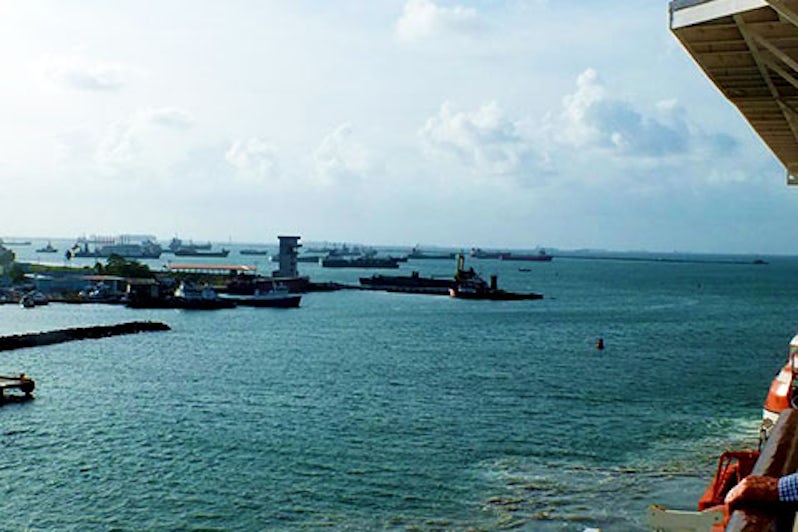
Just an hour or so after we returned from our shore excursions, our short stop in Colon was over and our Panama adventure complete. Next stop: Cartagena, Colombia. As Infinity headed into the Atlantic, we saw many ships anchored at the entrance to the canal. Most were waiting in line for his or her turn to enter the canal, but there were undoubtedly a few rookies stuck there for a while who thought they could pay the toll with an American Express card. Bon voyage!